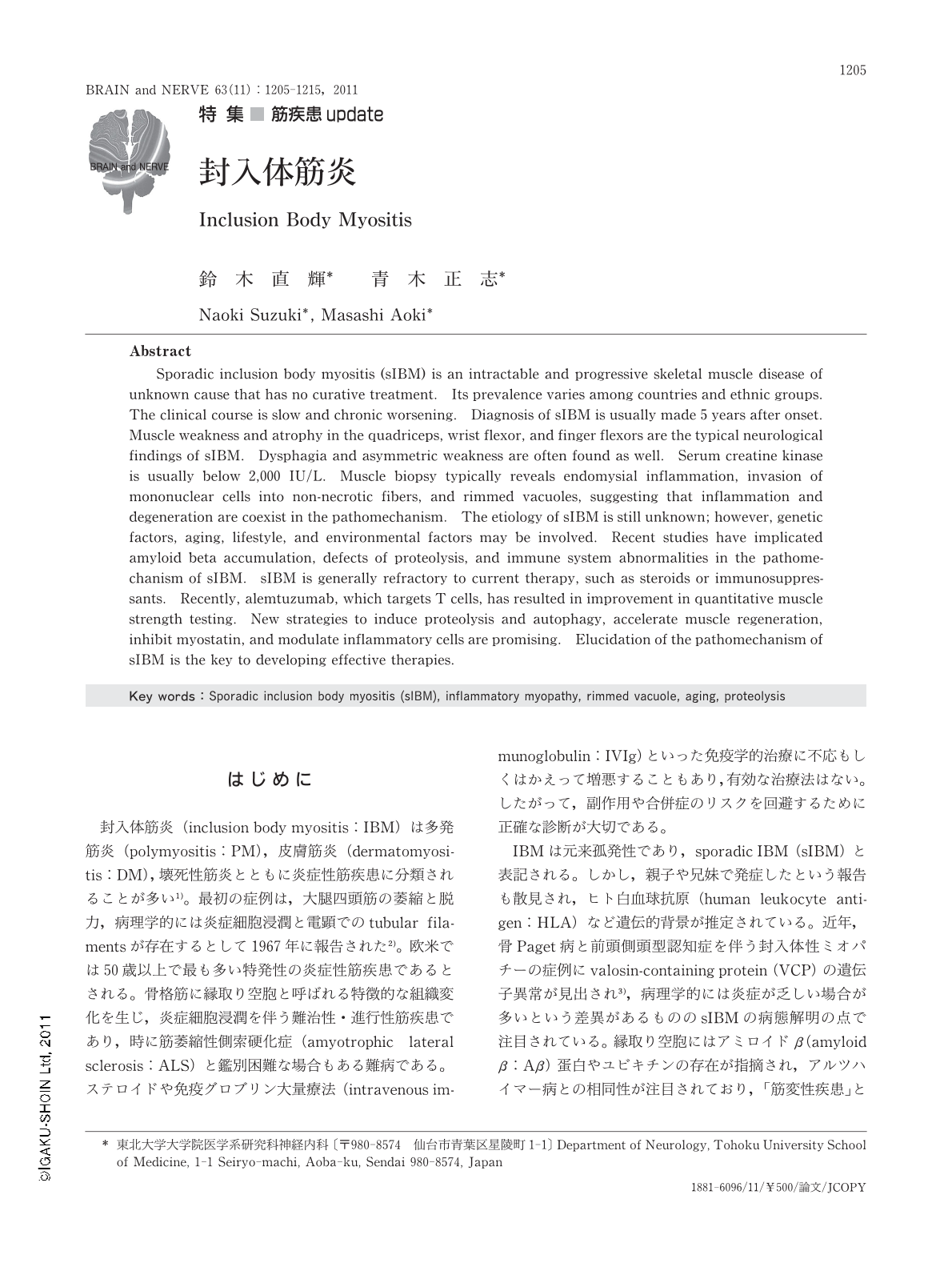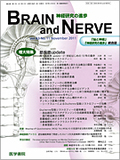Japanese
English
- 有料閲覧
- Abstract 文献概要
- 1ページ目 Look Inside
- 参考文献 Reference
はじめに
封入体筋炎(inclusion body myositis:IBM)は多発筋炎(polymyositis:PM),皮膚筋炎(dermatomyositis:DM),壊死性筋炎とともに炎症性筋疾患に分類されることが多い1)。最初の症例は,大腿四頭筋の萎縮と脱力,病理学的には炎症細胞浸潤と電顕でのtubular filamentsが存在するとして1967年に報告された2)。欧米では50歳以上で最も多い特発性の炎症性筋疾患であるとされる。骨格筋に縁取り空胞と呼ばれる特徴的な組織変化を生じ,炎症細胞浸潤を伴う難治性・進行性筋疾患であり,時に筋萎縮性側索硬化症(amyotrophic lateral sclerosis:ALS)と鑑別困難な場合もある難病である。ステロイドや免疫グロブリン大量療法(intravenous immunoglobulin:IVIg)といった免疫学的治療に不応もしくはかえって増悪することもあり,有効な治療法はない。したがって,副作用や合併症のリスクを回避するために正確な診断が大切である。
IBMは元来孤発性であり,sporadic IBM(sIBM)と表記される。しかし,親子や兄妹で発症したという報告も散見され,ヒト白血球抗原(human leukocyte antigen:HLA)など遺伝的背景が推定されている。近年,骨Paget病と前頭側頭型認知症を伴う封入体性ミオパチーの症例にvalosin-containing protein(VCP)の遺伝子異常が見出され3),病理学的には炎症が乏しい場合が多いという差異があるもののsIBMの病態解明の点で注目されている。縁取り空胞にはアミロイドβ(amyloid β:Aβ)蛋白やユビキチンの存在が指摘され,アルツハイマー病との相同性が注目されており,「筋変性疾患」と分類し直すべき病態と考えられる。なお,縁取り空胞を伴う遠位型ミオパチー(distal myopathy with rimmed vacuole:DMRV)は本邦のNonakaらによって初めて報告された4)。しかし,欧米では遺伝性封入体ミオパチー(hereditary inclusion body myopathy:hIBM)と呼称されることもある。炎症細胞浸潤に乏しくmyositisではなくmyopathyの略語であることに注意が必要である。シアル酸合成酵素であるGNE遺伝子の異常を認める常染色体劣性遺伝疾患でありsIBMとは異なる概念である。
本稿では,sIBMの臨床的特徴や病態・治療の現状に触れる。また,日本人でのsIBMについても厚生労働省難治性疾患克服研究事業の成果を交えて報告する。
Abstract
Sporadic inclusion body myositis (sIBM) is an intractable and progressive skeletal muscle disease of unknown cause that has no curative treatment. Its prevalence varies among countries and ethnic groups. The clinical course is slow and chronic worsening. Diagnosis of sIBM is usually made 5 years after onset. Muscle weakness and atrophy in the quadriceps,wrist flexor,and finger flexors are the typical neurological findings of sIBM. Dysphagia and asymmetric weakness are often found as well. Serum creatine kinase is usually below 2,000 IU/L. Muscle biopsy typically reveals endomysial inflammation,invasion of mononuclear cells into non-necrotic fibers,and rimmed vacuoles,suggesting that inflammation and degeneration are coexist in the pathomechanism. The etiology of sIBM is still unknown; however,genetic factors,aging,lifestyle,and environmental factors may be involved. Recent studies have implicated amyloid beta accumulation,defects of proteolysis,and immune system abnormalities in the pathomechanism of sIBM. sIBM is generally refractory to current therapy,such as steroids or immunosuppressants. Recently,alemtuzumab,which targets T cells,has resulted in improvement in quantitative muscle strength testing. New strategies to induce proteolysis and autophagy,accelerate muscle regeneration,inhibit myostatin,and modulate inflammatory cells are promising. Elucidation of the pathomechanism of sIBM is the key to developing effective therapies.

Copyright © 2011, Igaku-Shoin Ltd. All rights reserved.


